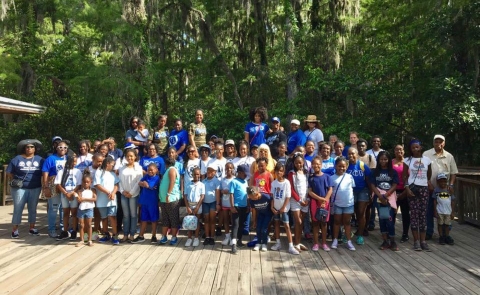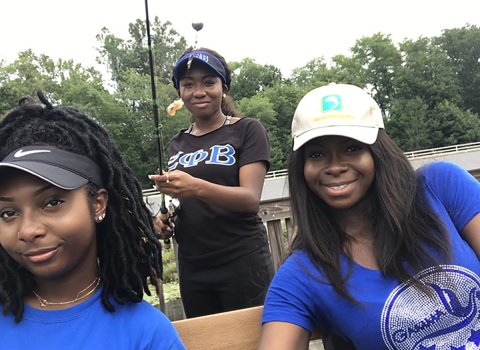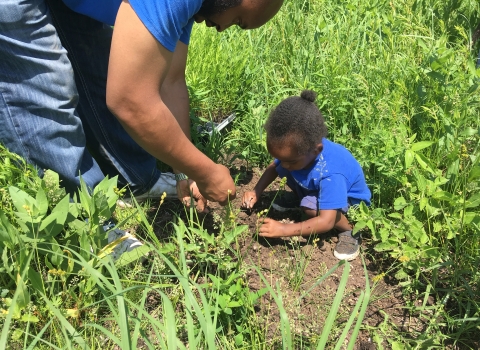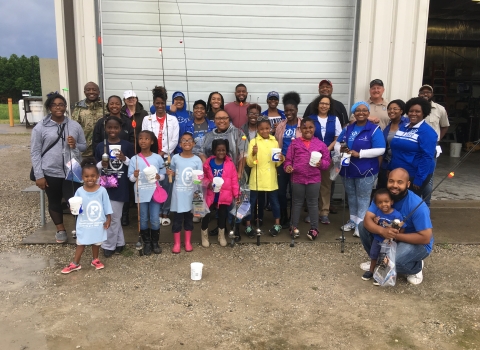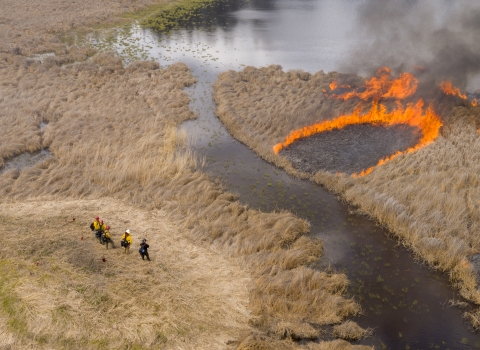Sierra Snyder is an intern at the U.S. Fish and Wildlife Service. She is a recent graduate of Morgan State University in Baltimore, Maryland, and a proud member of the Gamma Chapter of Zeta Phi Beta Sorority, Inc. Doves in the Wild is a blog series providing her perspectives, and those of her Sorority sisters, on conservation and experiencing nature.
Zeta Phi Beta Sorority, Inc. is a sorority of many firsts. They are the first to charter a chapter in Africa, the first to form auxiliary groups, and the first and only sorority in the National-Pan-Hellenic Council to be constitutionally bound to a fraternity, Phi Beta Sigma Fraternity, Inc.
Naturally then, Zetas across the country were delighted to go to national wildlife refuges and participate in something different for the first time. Many members had never even heard of a national wildlife refuge national wildlife refuge
A national wildlife refuge is typically a contiguous area of land and water managed by the U.S. Fish and Wildlife Service for the conservation and, where appropriate, restoration of fish, wildlife and plant resources and their habitats for the benefit of present and future generations of Americans.
Learn more about national wildlife refuge , but when it comes to changing the norms and defying stereotypes, Zetas are trailblazers. This May during the Zeta Days at the Refuge initiative, sorority members took national wildlife refuges by storm!
Bird watching and identification were two of the many new activities that members had the opportunity to participate in. National wildlife refuges are home to many different species of birds. While sorority members ideally favor the dove, they learned that nature consists of many more and unique and fascinating birds. At the Gibraltar Bay unit of Detroit River International Wildlife Refuge in Michigan, the Lambda Rho Zeta chapter learned about the birds that migrated to the area and were able to identify them on their tour of the refuge.
Rita M. McGregor of the Zeta Nu Zeta chapter, has been the coordinator for the southeastern Michigan FWS visits for the past two years still enjoys the serenity of the refuge like it’s her first time.
“I’m a nature girl. I love being outdoors. I like looking at wildlife, walking and exploring new areas by looking at the river. It has a calming effect. I enjoyed the lecture given by the park ranger on the different animals that inhabited the refuge,” said McGregor. “I love that we bring children that may not have an opportunity to play outside due to their environment.” Needless to say, it was a new and memorable experience for all members present!
Sorority member Harriet Hamilton recalled visiting Patuxent Research Refuge in Maryland with the Beta Zeta chapter where she observed and learned the behaviors and special characteristics of the screech owl. “This particular breed is a silent flyer and a very lazy predator,” Hamilton said.
Not only did she learn about bird identification but she also declared Patuxent Refuge as her new favorite place!
After discovering that the refuge is less than 20 minutes from her home, it is safe to say that she will be returning soon! Her favorite part about the refuge was the educational resources they provided for youth. “It has a tram that can take you on a tour around the refuge grounds, a movie theater for films about environmental issues and a "make and take "area for children,” Hamilton said. “They also provide opportunities for different school groups during the year, camps during the summer and teacher workshops year around.”
At Great Dismal Swamp National Wildlife Refuge, in southeastern Virginia and northeastern North Carolina, members of the Gamma Alpha Delta Zeta chapter learned about water animals. Zetas then did their part to fight one of the threats facing aquatic wildlife -- pollution -- and cleaned up around the area. Additionally, they were educated on fire safety and how to protect themselves from outdoor elements and animals. Chapter members appreciated the experience, describing it as great and beneficial for the young ladies of the youth auxiliary. Most of the youth chapter members brought to the refuge had never been to one before and did not know what to expect.
Sorority member Colleen Green had a rich and rewarding experience in the nature photography workshop at John Heinz National Wildlife Refuge in Philadelphia. “I learned how to photograph the various aspects of plants and how to use the light to capture textures. This experience helped me to gain a better appreciation for wildlife photography and the skills required to capture a winning picture.” Colleen said. “I would encourage others to take time to explore your local nature areas and to search the U.S. Fish Wildlife Service Website to find out about the community service activities and educational opportunities they offer.”
It is important to expose our youth to a wide range of activities to diversify their interests. Maybe a child would have an interest in something like wildlife photography if they had a chance to learn about it. It is 2018 and we are still working toward African-Americans having representation in every field and aspect of life. It is important to show our youth that they can accomplish anything that they put their mind to and the color of their skin does not determine what they do or where they will end up in life.
Zeta Phi Beta Sorority members and their youth auxiliaries took a step out of their comfort zone and into the wild! So many were able to partake in so many new experiences and make memories at national wildlife refuges. From learning the different types of flowers and birds to identifying animals and going on scavenger hunts, it’s safe to say that the members will be returning for some more natural fun! One can take inspiration from these "finer women" enthusiastic about making strides in exposing minority youth to nature and the great outdoors.
This story is from our Open Spaces blog.


